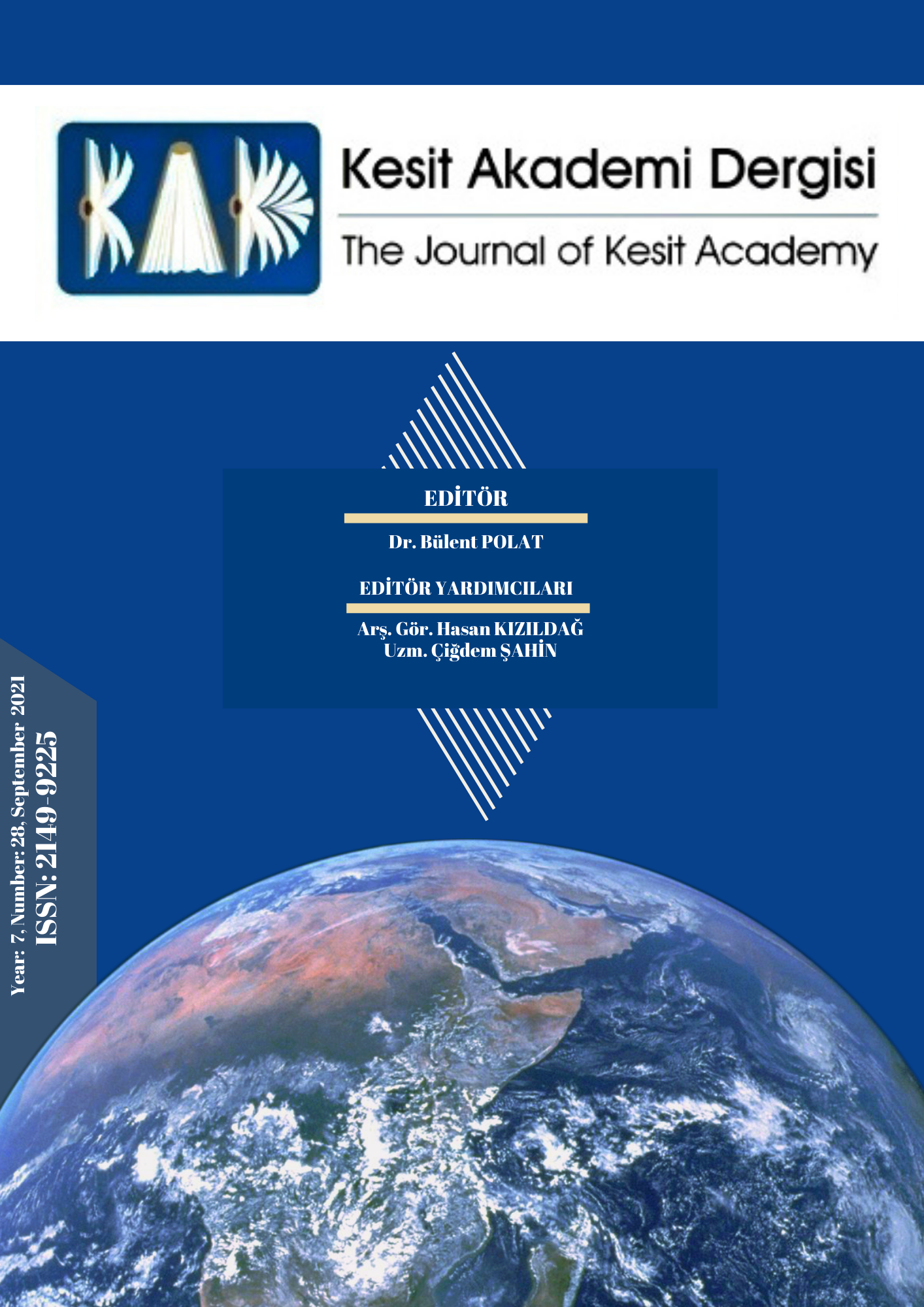ALTINCI SINIF ÖĞRENCİLERİNİN İNSAN VE ÇEVRE ÜNİTESİNİ ANLAMALARINDA İLLÜSTRASYONLARIN ETKİSİ HAKKINDA GÖRÜŞLERİ
Author :
Abstract
Çalışmanın amacı, altıncı sınıf öğrencilerinin insan ve çevre ünitesini anlamalarında illüstrasyonların etkisi hakkında görüşlerini araştırmaktır. Araştırmada, katılımcıların insan ve çevre ünitesini anlamalarında illüstrasyonların etkisi hakkında görüşlerini doğru, derinlemesine ve hassas bir şekilde ortaya çıkarmak öngörüldüğünden betimsel model kullanılmıştır. Çalışmaya 11’i kız, 19’u erkek olmak üzere toplam 30 altıncı sınıf öğrencisi katılmıştır. Çalışmanın verileri uzman görüşü alınarak hazırlanan açık uçlu beş sorunun ve dört illüstrasyonun bulunduğu bir görüş formu kullanılarak elde edilmiştir. Veri toplama aracı uygulanmadan önce çalışma grubuna araştırmada kullanılması düşünülen illüstrasyonlarla ilgili 10-15 dakikalık bir sunum yapılmıştır. Öğrencilerin açık uçlu soruların ilk dördüne yazarak verdiği cevaplar, yaptıkları açıklamalar ve beşinci sorunun cevabı için çizdikleri görseller; incelenerek içeriklerine, benzerliklerine ve yakınlıklarına göre gruplandırılmıştır. Gruplandırılan cevaplar ve görseller, cevaplara dair açıklamalar, cevapları yazan ve görselleri çizen kız-erkek, toplam öğrenci sayıları ve yüzdeleri farklı sütunlarda olacak şekilde ilgili tablolara aktarılmıştır. Her tablonun bitiminde içerdiği verilerle ilgili gerekli yorum ve açıklamalar yapılmıştır. Çalışmada ortaya çıkarılan öğrenci görüşleri illüstrasyonların etkileri konusunda önemli bulgular sağlamıştır. Ulaşılan bulgulara dayanılarak illüstrasyonların öğrencilerde güdüleme, öğrenilenlerin veya bilginin kalıcılığını sağlama, yaşanabilir bir çevre için daha duyarlı davranma ve bazı faaliyetleri gönüllü yürütme gibi olumlu etkiler oluşturabileceği iddia edilebilir.
Keywords
Abstract
The purpose of the study is to investigate the views of sixth grade students about the effect of illustrations on their understanding of the unit “human and environment”. The descriptive model was used in the study, as it was intended to reveal the views of the participants about the effect of illustrations in an accurate, in-depth and sensitive way in understanding the unit of human and environment. A total of 30 sixth grade students, 11 girls and 19 boys, participated in the study. The data of the study were obtained using an opinion form with five open-ended questions and four illustrations prepared by taking expert opinion. Before applying the data collection tool, a 10-15 minute presentation was made to the study group about the illustrations that were considered to be used in the study. The answers given by the students by writing to the first four of the open-ended questions, their explanations and the visuals they drew for the answer to the fifth question were examined and grouped according to their content, similarities and closeness. The grouped answers and visuals, explanations about the answers, the total numbers and percentages of male and female students who wrote the answers and drew the images were transferred to the relevant tables in different columns. At the end of each table, necessary comments and explanations were made about the data it contains. The students' opinions revealed in the study provided important findings about the effects of illustrations. Based on the findings, it can be argued that illustrations can have positive effects such as motivation for students, ensuring the permanence of what has been learned or knowledge, acting more sensitively for a livable environment, and conducting some activities voluntarily.
Keywords
- Ambrose, G. ve Harris, P. (2014). Görsel grafik tasarım sözlüğü (Çev. Ed.: B. Barhana). Literatür Yayıncılık.
- Bakaç, E. ve Yıldız, A. (2021). Öğretmen adaylarının bilimsel süreç becerilerini anlama düzeyleri ve öğretim elemanlarının onların cevapları hakkındaki tahminleri. Ağrı İbrahim Çeçen Üniversitesi Sosyal Bilimler Enstitüsü Dergisi, 7(1), 453-481. Doi:10.31463/aicusbed.870717
- Büyüköztürk, Ş., Kılıç Çakmak, E., Akgün, Ö. E., Karadeniz, Ş., ve Demirel, F. (2017). Bilimsel araştırma yöntemleri (23. baskı). Pegem Akademi.
- Cohen, L., Manion, L., & Morrison, K. (2000). Research methods in education (5th ed.). Routledge.
- Doğan, M. (1997). Türkiye ulusal çevre stratejisi ve eylem planı eğitim ve katılım grubu raporu. DPT Müsteşarlığı ve Türkiye Çevre Vakfı.
- Dursun, N. (2013). Evrimleşen grafik ile illüstrasyon ve animasyon ilişkisi (Tez No. 299754) *Yüksek Lisans Tezi]. İstanbul Arel Üniversitesi.
- Erdoğan, A. ve Cerrah-Özsevgeç, L. (2012). Kavram karikatürlerinin öğrencilerin kav- ram yanılgılarının giderilmesi üzerindeki etkisi: Sera etkisi ve küresel ısınma örneği. Turkish Journal of Education, 1(2), 38-50. Doi:10.19128/turje.181046
- Ertürk, H. (1996). Çevre bilimlerine giriş. Uludağ Üniversitesi Güçlendirme Vakfı, No:10, Bursa.
- Future Climate Dialogues (2013). Future climate dialogues. Retrieved May 01, 2014 from http://www.aber.ac.uk/en/art/news-events/future-climate-dialogues/
- Güney, E. (2002). Genel çevre kirlenmesi (3. baskı). Çantay Kitabevi.
- Haila, Y. ve Levins, R. (1992). Humanity and nature: ecology, science and society. Pluto Press.
- İleri, R. (1998). Çevre eğitimi ve katılımın sağlanması. Ekoloji Dergisi, 7(28), 3-9.
- Özer, Ö. (1998). Çevre konusunda tanımlar ve açıklamalar; Çevre sorunlarına giriş. Mobil Yayınları.
- Türe, C. (2014). Küresel iklim değişikliğinin toplumsal algısında görsel sanatların rolü. Sanat ve Tasarım Dergisi, 6(6), 224 - 239. https://doi.org/10.20488/austd.88679
- Vaughan, C., Gack, J., Solorazano, H., & Ray, R. (2003). The effect of environmental education on schoolchildren, their parents, and community members: A study of ıntergenerational and ıntercommunity learning. Journal of Environmental Education, 34(3), 12-21.
- Wigan, M. (2012). Görsel illüstrasyon sözlüğü (Çev. Ed.: M. E. Uslu). Literatür Yayıncılık.
- Yıldırım, A., & Şimşek, H. (2018). Sosyal bilimlerde nitel araştırma yöntemleri (11. baskı). Seçkin Yayınları.
- Yıldız, A. (2018). Pre-service teachers’ views regarding the effect of learning scientists’ biographies on students’ motivation. European Journal of Education Studies, 5(2), 133-143. doi:10.5281/zenodo.1421189
- Yıldız, K., Sipahioğlu, Ş., & Yılmaz, M. (2011). Çevre bilimi ve eğitimi (2. baskı). Gündüz Eğitim ve Yayıncılık.
- Yılmaz, I. N., & Önal, E. (2017, 25-26 Kasım). Küresel ısınma ve iklim değişikliği bilinçlen- dirme çalışmalarına illüstratif yaklaşımlar *Sözlü bildiri+. Uluslararası Multidisipliner Çalışmaları Kongresi, Antalya.





